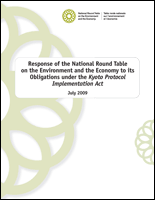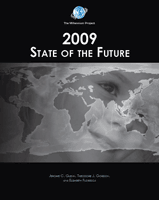
News |
- Time is Running Out for Negotiations
- Online Tools Encourage 'Green' Towns
- Oilsands Cause Acid Rain in Saskatchewan
- Response To Canada's Climate Plan
- 2009 State of the Future
- Coalition Demands Provinces Do Their Share
- Wind Turbines Cause Health Risks
- Renewable Energy Regulations Spur Reaction
- Towards Tropical Conservation of Biodiversity
- Victory for Sage Grouse
- Hydro Line Could Cost WHS Listing
- LP Pollution Being Investigated
| Time is Running Out for Negotiations | 19 August 09 |
 The slow pace of international climate talks is raising concerns over reaching a comprehensive climate agreement in Copenhagen December 2009. With just 100 days remaining, more talks are scheduled in Bangkok Sept. 28 - Oct. 9, and in Barcelona, Spain Nov. 2 - 6. The slow pace of international climate talks is raising concerns over reaching a comprehensive climate agreement in Copenhagen December 2009. With just 100 days remaining, more talks are scheduled in Bangkok Sept. 28 - Oct. 9, and in Barcelona, Spain Nov. 2 - 6. 2,400 delegates from 180 nations met in Bonn, Germany for preparatory talks under the UN Framework Convention on Climate Change (UNFCCC). The meetings were intended to shorten the huge 200-page draft negotiating text outlining options for combating global warming. The main stumbling blocks include level and source of financial support and scale of emission reductions. Poor countries want support for mitigation and adaptation to come from developed nations since they are historically responsible for climate change. Industrialize countries have tabled emission reduction pledges of 15 to 21 percent below 1990 levels, which will not stop global warming from surpassing the critical 2 degree Celsius threshold. View August 2009 UNFCCC articleView August 11, 2009 Reuters article View August 10, 2009 Reuters video View August 18, 2009 EurActiv.org article View August 14, 2009 WWF article View August 14, 2009 New York Times article Sources: UNFCCC, Reuters, Planet Ark, New York Times |
|
 Print version Print version |
Top |
| Online Tools Encourage 'Green' Towns | 19 August 09 |
 A new web portal is empowering local citizens and decision makers to bring about grassroots changes towards 'greener' communities. The initiative "How Green is My Town" (HGIMT) offers a 200-plus page online tool with resources on climate change, sustainability and environmental health. A new web portal is empowering local citizens and decision makers to bring about grassroots changes towards 'greener' communities. The initiative "How Green is My Town" (HGIMT) offers a 200-plus page online tool with resources on climate change, sustainability and environmental health.The HGIMT website checklist determines your town's green efforts with a toolbox of program ideas and links to innovative solutions. Materials are divided into three sectors: local government, school system and business community. The Columbia Institute offers a similar online resource tool for communities and local elected leaders in Canada. The Centre for Civic Governance supports community leadership to address social and environmental challenges through sharing best practices. View How Green is My Town? websiteView Aug 10, 2009 Green Economy Post article View May 5, 2009 Reuters article View Columbia Institute - Centre for Civic Governance Sources: How Green is My Town website, Green Economy Post, Columbia Institute |
|
 Print version Print version |
Top |
| Oilsands Cause Acid Rain in Saskatchewan | 14 August 09 |
 Average pH levels for rainfall data in northwestern Saskatchewan are now three times as acidic as unpolluted rainfall. Environmentalists are calling on the federal government to set caps on Alberta oilsands acid-rain causing-emissions. Average pH levels for rainfall data in northwestern Saskatchewan are now three times as acidic as unpolluted rainfall. Environmentalists are calling on the federal government to set caps on Alberta oilsands acid-rain causing-emissions.The Saskatchewan Environmental Society obtained data from the Saskatchewan government that shows average pH levels for rain and snow in the La Loche area, just west of Fort McMurray, Alberta, are 4.93. According to Environment Canada any value less than five falls under the definition for acid rain. Alberta's oilands emit more than 150,000 tonnes nitrous oxide and sulfur dioxide, acid-rain-causing gases, every year. Increased soil acid damages tree roots and leaches nutrients too deep for plants to use. Sufficient acid rain kills all lake species. Up to 70 percent of this oilsands air pollution crosses the provincial boundary. Canadian federal regulation and policy regulates acid rain, including acid rain from oilsands emissions. View August 10, 2009 Saskatchewan Environmental Society press releaseView August 10, 2009 CBC news article View August 12, 2009 Canadian Press article View August 12, 2009 Prince Albert Herald article View August 13, 2009 Edmonton Sun article Sources: Saskatchewan Environmental Society, CBC, The Canadian Press |
|
 Print version Print version |
Top |
| Response To Canada's Climate Plan | 14 August 09 |
 The National Round Table on the Environment and the Economy (NRTEE) has released their annual review of Canada's Climate Change Plan. The National Round Table on the Environment and the Economy (NRTEE) has released their annual review of Canada's Climate Change Plan.
The Kyoto Protocol Implementation Act requires Canada to prepare a Plan that describes the measures and policy actions taken to meet its obligations under the Kyoto Protocol to reduce greenhouse gas emissions to 6 percent below 1990 levels by 2010. NRTEE reviewed "A Climate Change Plan for the Purposes of the Kyoto Protocol Implementation Act - May 2009". NRTEE concluded that many of the emission reductions attributed to specific measures and policies are overestimated. The NRTEE also questions whether it was sufficient to rely on Canada's KPIA annual assessment approach with its short-term focus and unclear definitions. View July 2009 NRTEE's Response to its Obligations under the Kyoto Protocol Implementation ActView the NRTEE's website Sources: NRTEE |
|
 Print version Print version |
Top |
| 2009 State of the Future | 13 August 09 |
 According to a new UN report, 50 percent of the world is at risk of social conflict and violence due to the global recession and climate change. Solutions to these enormous issues must be addressed at a global scale. According to a new UN report, 50 percent of the world is at risk of social conflict and violence due to the global recession and climate change. Solutions to these enormous issues must be addressed at a global scale.The major findings of the United Nation's Millennium Project's annual State of the Future report card include:
View August 7, 2009 Earth News article View August 6, 2009 PR Newswire article View August 5, 2009 Mongabay article Sources: Earth News, PR Newswire |
|
 Print version Print version |
Top |
| Coalition Demands Provinces Do Their Share | 11 August 09 |
 A coalition of leading Canadian organizations called on premiers in Regina for Council of the Federation meetings to agree to more ambitious climate change action and targets for Canada. With only months to go before the most important United Nations climate change conference to date, the groups argue that all provinces, including Alberta, should do their fair and equitable share. A coalition of leading Canadian organizations called on premiers in Regina for Council of the Federation meetings to agree to more ambitious climate change action and targets for Canada. With only months to go before the most important United Nations climate change conference to date, the groups argue that all provinces, including Alberta, should do their fair and equitable share.The groups ask the premiers to show the way forward for Canada by:
"Canadians want to be part of the solution to climate change. But citizens can't do it alone. They expect the premiers and Prime Minister to work constructively to ensure that Canada implements an effective climate action plan to reduce emissions with strong science-based targets," says Ian Bruce, climate change specialist with the David Suzuki Foundation. View July 30, 2009 David Suzuki Foundation briefingView August 6, 2009 Climate Action Network news release View August 6, 2009 Pembina Institute briefing, Highlights of Provincial Greenhouse Gas Reduction Plans View August 6, 2009 News Talk 650 article Sources: Climate Action Network |
|
 Print version Print version |
Top |
| Wind Turbines Cause Health Risks | 07 August 09 |
 New research exposes the health risks of wind energy turbines including heart disease, vertigo, panic attacks, migraines, increased heart rate and sleep deprivation. New research exposes the health risks of wind energy turbines including heart disease, vertigo, panic attacks, migraines, increased heart rate and sleep deprivation.Dr. Nina Pierpont, a leading New York pediatrician, studied 10 families living near wind farms. Most of the individuals developed a range of health illnesses, labeled as Wind Turbine Syndrome (WTS). Dr. Pierpont's full thesis is to be published in October. The research found that low-frequency noise and vibrations emitted by wind turbines affect human vestibular system or ear bones, which are responsible for balance and spatial orientation. Dr. Pierpont recommends a minimum distance of 2 km between wind turbines and residences. Previous research and acoustic engineers working for the wind industry have denied health risks. Governments in Denmark, Germany and France are moving towards building off-shore wind farms in response to concerns over potential health risks. View Wind Turbine SyndromeView Wind Turbine Syndrome for Non-Clinicians - Draft Copy (PDF) View August 2, 2009 The Independent article View August 3, 2009 Reuters article View August 4, 2009 Business Green article Sources: The Independent, Reuters |
|
 Print version Print version |
Top |
| Renewable Energy Regulations Spur Reaction | 05 August 09 |
 The Province of Ontario's proposed regulations to streamline the approval process for renewable energy projects have solicited reaction. The regulations fall under the Green Energy Act, 2009, which encourages the development of clean and renewable sources of energy including wind, solar, biomass and biogas power. The Province of Ontario's proposed regulations to streamline the approval process for renewable energy projects have solicited reaction. The regulations fall under the Green Energy Act, 2009, which encourages the development of clean and renewable sources of energy including wind, solar, biomass and biogas power.The public commenting period on the Ministry of the Environment and Ministry of Natural Resources proposed requirements for the application, review and decision-making process for Renewable Energy Approvals ended July 24, 2009. Groups raised concerns over the health effects of wind turbines. The MOE has proposed generous setbacks of 550 meters from dwellings and 125 meters from property lines, roads and railroads. Supporters fear the setbacks could eliminate three-quarters of the wind turbine projects set for construction. View July 29, 2009 Mondaq articleView August 3, 2009 The Toronto Star article View June 9, 2009 Ontario Government Environment press release View June 9, 2009 Ontario Government Environment - Approval Process View Ontario Green Energy Act View 2009 Proposed Ministry of the Environment Regulations to Implement the Green Energy and Green Economy Act View Draft Approval and Permitting Requirements for Renewable Energy Projects Developed by the Ministry of Natural Resources Sources: Government of Ontario, The Toronto Star, Mondaq |
|
 Print version Print version |
Top |
| Towards Tropical Conservation of Biodiversity | 05 August 09 |
 Representatives from three major regional organizations in the Amazon, Congo and Borneo - home to the world's three largest tropical forests, have agreed to work together to enhance conservation and sustainable management of their forest's biodiversity. Representatives from three major regional organizations in the Amazon, Congo and Borneo - home to the world's three largest tropical forests, have agreed to work together to enhance conservation and sustainable management of their forest's biodiversity.
The Secretariat of the Convention on Biological Diversity (SCBD) hosted the meeting in Montreal on South-South Cooperation to share knowledge and improve the success of the regional organizations. (Association of Southeast Asian Nations (ASEAN), Amazon Cooperation Treaty Organization (ACTO), Central Africa Forests Commission (COMIFAC).) "This meeting has been a great success in bringing together the expertise and experience of the three regional bodies, and to initiate a process of learning from each other," said Raman Letchumanan from the ASEAN Secretariat. Results of the meeting will be considered when developing a multi-year plan of South-South Cooperation on biodiversity. View July 17, 2009 Association of Southeast Asian Nations releaseView July 16, 2009 Convention on Biological Diversity article (PDF) View July 8, 2009 Convention on Biological Diversity - Report of the Meeting (DOC) Sources: ASEAN, Convention on Biological Diversity |
|
 Print version Print version |
Top |
| Victory for Sage Grouse | 29 July 09 |
 Environmentalists have won a legal battle lead by Ecojustice in asking the courts to reject Environment Canada's recovery strategy for the endangered greater sage grouse. The recovery strategy proposed last year under the Species at Risk Act failed to identify critical habitat to be protected. Environmentalists have won a legal battle lead by Ecojustice in asking the courts to reject Environment Canada's recovery strategy for the endangered greater sage grouse. The recovery strategy proposed last year under the Species at Risk Act failed to identify critical habitat to be protected.A Federal Court ruled although not illegal, it was unreasonable for the government to claim it could not identify breeding grounds and critical habitat. The judge gave both sides a month to come up with a plan to revise the grouse's recovery strategy. "The sage-grouse case will put an end to years of government inaction. There is reason to believe endangered species across Canada will finally receive protection with federal courts forcing the government to obey its own laws," said Alberta Wilderness Association vice-president Cliff Wallis. The sage grouse, found across southern Alberta and Saskatchewan have been listed as endangered since 1998. Agriculture, roads, and oil and gas development has fragmented their habitat range, reducing it from 100,000 to 6,000 square kilometers. View July 15, 2009 Globe and Mail articleView July 13, 2009 CBC article View July 13, 2009 Canadian Press article View July 15, 2009 Vancouver Sun article Sources: Globe and Mail, CBC
Photo Source: Wikimedia Commons |
|
 Print version Print version |
Top |
| Hydro Line Could Cost WHS Listing | 28 July 09 |
 A proposed 40-meter-high transmission line through Gros Morne National Park in western Newfoundland could jeopardize its UNESCO World Heritage Site (WHS) listing. A proposed 40-meter-high transmission line through Gros Morne National Park in western Newfoundland could jeopardize its UNESCO World Heritage Site (WHS) listing.Nalcor Energy's preferred route for its transmission corridor would cross Gros Morne and is drawing strong criticism. The lines connect the massive $10-billion Lower Churchill hydroelectric project in Labrador to Newfoundland. Gros Morne is one of the province's most popular tourist destinations and is known for its fiords and stunning scenery. Each national park in Canada also contributes to the regional economy significantly. UNESCO previously removed a site in Germany from its list after construction of a four-lane bridge. Listing, and delisting decisions are based on UNESCO standards for world heritage sites. Newfoundland Premier Danny Williams has said it might be too expensive to build the transmission line around the park, and that he is willing to risk the WHS to cut development costs. Construction of the project could start as early as 2010 if a panel of provincial and federal representatives approve the project's environmental assessment. View Gros Morne National Park of CanadaView UNESCO World Heritage - Gros Morne National Park View July 6, 2009 CBC article View July 22, 2009 The Western Star article View July 22, 2009 The Western Star second article View July 9, 2009 CBC article View July 7, 2009 Canadian Press article Sources: CBC, The Western Star |
|
 Print version Print version |
Top |
| LP Pollution Being Investigated | 22 July 09 |
 Louisiana Pacific Corporation (LP), holder of the newest and most southern forest management and woodlands rights in Canada, is being investigated. The issue at the Swan Valley Manitoba mill centers on whether to allow emissions and pollution to be deregulated. Manitoba's Conservation minister approved a shut down of the mill's pollution abatement equipment at the LP OSB plant in Swan Valley early in 2009. No public review was conducted at that time. Louisiana Pacific Corporation (LP), holder of the newest and most southern forest management and woodlands rights in Canada, is being investigated. The issue at the Swan Valley Manitoba mill centers on whether to allow emissions and pollution to be deregulated. Manitoba's Conservation minister approved a shut down of the mill's pollution abatement equipment at the LP OSB plant in Swan Valley early in 2009. No public review was conducted at that time.Due to reaction from the community living around the mill, the minister has now asked Manitoba's Clean Environment Commission to conduct an investigation and make recommendations as to permanent shut down of the pollution abatement equipment (called "regenerative thermal oxidizers" or RTOs). The CEC public meetings are being held in the last week of July 2009. A transcript and public posting of presentations will be on the CEC web site. Recommendations to the minister follow. View CEC Manitoba - LP Oriented Strandboard Plant Air Emissions pageView Manitoba Government LP Public Registry files Visit LP Swan Valley Forest website View July 20, 2009 Larry Powell article at OnEarth Sources: CEC, OnEarth, LP, Manitoba Government |
|
 Print version Print version |
Top |


 RSS Feeds:
RSS Feeds: